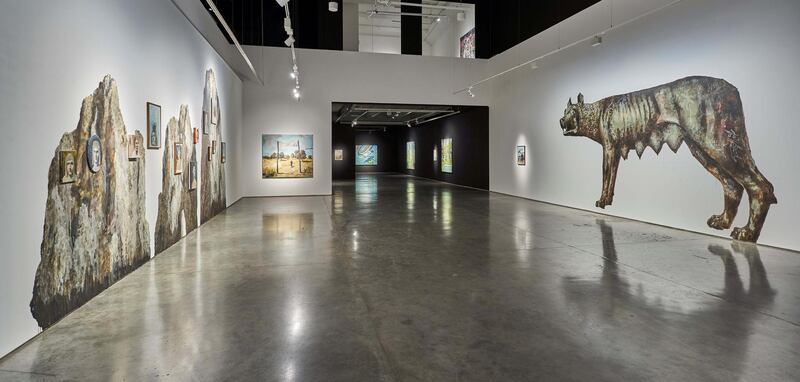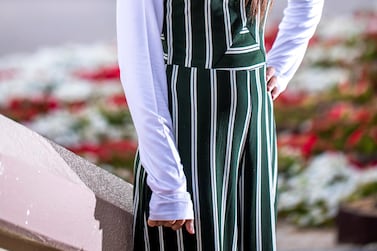Art Dubai and Sikka Art Fair are fan favourites, but a visit to the warehouses of Alserkal Avenue in Dubai should also be on your agenda this year. From clay works to a study of the Emirates' architectural heritage, there are many exhibitions to see.
Tibe Now: Free Drinks, Boots and Tickets to the Apocalypse by Philip Mueller at Salsali Private Museum
Open until May 31
Founded by Ramin Salsali in 2011, Salsali Private Museum has hosted 18 exhibitions to date from Salsali’s significant collection of Middle Eastern and international artists. However, Tibe Now: Free Drinks, Boots and Tickets to the Apocalypse is the last show it will hold in Dubai.
SPM's final exhibition includes existing works from the collection as well as new and site-specific works from Austrian painter Philip Mueller (above). The exhibition follows the journey of the artist's practice by tracing the evolution of series including Black Flamingo Sad Boys (BFSB), Der Berg and Mutters. His work focuses on the contemporary culture of excess as well as historical symbolism, with apocalyptic undertones.
When the show closes at the end of May, the museum will relocate to Berlin. “Almost 10 years ago, I felt a need to start the museum in Dubai to support the cultural infrastructure, but now the need is much greater in Europe,” explains Salsali. “There are very few museums that exhibit or give space to contemporary art from the Middle East over there and especially in the climate of increasing cultural misunderstanding in which we live, it is vital to create a platform to bring people together in Europe. A museum is the best platform for cultural exchange.”
The Space Between the Eyelid and the Eyeball by Mohamed Ahmed Ibrahim at Lawrie Shabibi
Open until May 9
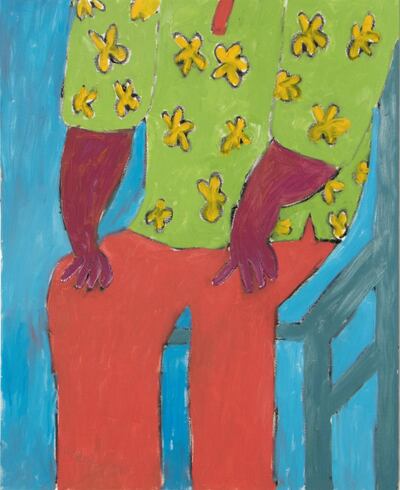
One of The Five, a group of artists informally dubbed the pioneers of contemporary art in the UAE, Ibrahim’s practice is shown across three distinct bodies of work in this survey exhibition. The main space is filled with small sculptures made from papier-mache in bright colours. The shapes are indistinct but also oddly familiar. They are animalistic and organic and made through a process that the artist describes as “subconscious” – with a focus only on creating rather than thinking.
Hanging on the walls are several pieces from the Sitting Man series, a repetitive process that the artist undertook over 10 years – painting the same portrait of a man sitting on a chair but depicted with neither his head or feet showing. The same bright colours are repeated, and the fact that the subject's head is missing alludes to the fact that you only need emotions rather than intellect to appreciate the artist's work. In the smaller room, Ibrahim has created a site- specific installation of black and white vertical lines in varying thicknesses and regularity. The lines have a temporal quality, denoting a rhythm and the passing of time: it is very immersive.
True Love by Johan Creten at Leila Heller Gallery
Open until July 18
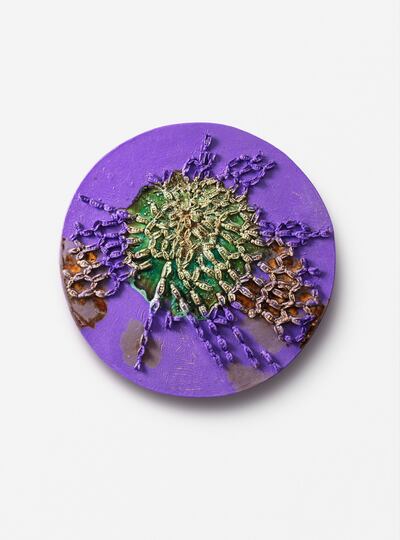
Although born in Sint-Truiden, Belgium, Creten has been on the move for 25 years, travelling from Mexico to Rome, and from Miami to Amsterdam. He currently lives in Paris. Creten started working with clay in the late 1980s and it is still his preferred medium. He uses it to explore the relationship between humanity and Earth.
Clay was the earliest material used by humankind to express themselves, and just as its use evolved over the centuries, Creten’s own employment of the material has progressed. It now goes far beyond the context of applied crafts and is part of the vocabulary of conceptual art. “I should, as an artist, have the ability to take an idea from one method of representation and carry it to another means of representation,” says Creten.
This exhibition, True Love, comprises ultra-textured ceramics glazed in gold, and while the shapes are abstract, they take their roots in nature and resemble organisms or structures built by animals. He takes inspiration from mythology and classical culture, but his language is firmly rooted in the contemporary sphere and, giving the works the full space of the vast Leila Heller Gallery allows this tribute of love for the Earth to shine and glow.
Facade to Facade by Hussain AlMoosawi at Gulf Photo Plus
Open until June 8
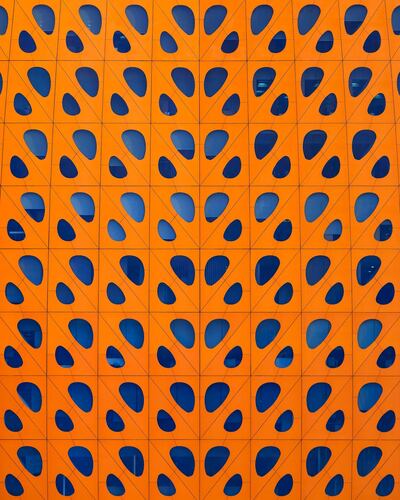
The growth of the UAE is exponential, and that dizzying rate of change has led the country to embrace dynamism, but also hold tight to its heritage to prevent it from slipping away in the tide of change. Facade to Facade is part of a larger ongoing project documenting the UAE’s architectural heritage in public places.
AlMoosawi is a photographer and graphic designer and has travelled across the UAE exploring notions of heritage in relation to the ever-changing urban landscape. The exhibition consists of facades of buildings from the 1970s, 1980s and 1990s, and at times the images are almost abstracted due to the artist’s choice to focus on detail, shapes and patterns.
This is an exhibition that explores elements of the UAE’s very unique culture. The photographer’s eye allows the viewer to witness changing trends in architecture and therefore reflect on the power of design upon our daily lives. This project also has an ongoing social purpose as it will help preserve the designs for future generations.
Blue by Hassan Sharif at Gallery Isabelle van den Eynde
Open until May 14
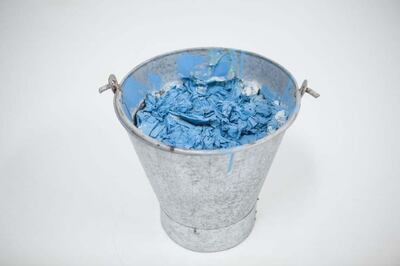
Since Sharif died in 2016, Gallery Isabelle van den Eynde has presented the archive of this unparalleled pioneer of Emirati contemporary art in a variety of insightful exhibitions. This one takes the colour blue as a thread to link several bodies of his prolific practice. Blue contains paintings, objects, boxes and experiments. In an untitled piece from 2016, a simple bucket stands filled with scrunched up pieces of blue tissue paper.
The same material is repeated in a set of three wall pieces, which speak of Sharif's interest in the contemporary age of excess. His work often used an accumulative process, which referred to the capitalist consumer culture that fills our lives with disposable and mass-produced objects, as in with Shoes, a wall full of tied up sneakers and slippers.
Also on show, however, is a painting from the Venus and Fish series of paintings from 2009, which has a surrealist aesthetic and a bold use of colour. Sharif challenged you to question the notion of what art is and how it functions. This exhibition is no different.
In Memory of the Arabesque by Kamrooz Aram at Green Art Gallery
Open until May 30
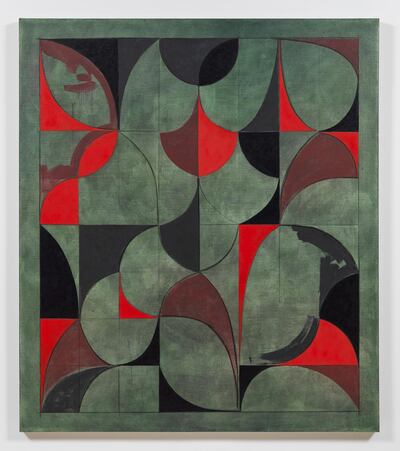
This exhibition contains paintings that explore the term “Arabesque” as it has been used in art history, as well as the multiple meanings the term has for the artist personally.
Generally, Arabesque is a term that refers to the leafy and floral forms seen on carpets or tiles, which function as a tool to move our eyes around the surface. However, taken more literally, the suffix “esque” can mean resembling, so the word translates to “Arab-like”. As an Iranian growing up in the United States, people assumed Aram was Arab so often that he said he “almost became Arab” and his interest in the word stems from there. “It occurs to me that I am ‘Arabesque’. It occurs to me that there is no such thing
as the ‘Arabesque’,” he said in the exhibition statement. Typically, Aram paints on a structured, grid-like surface, which he takes as a departure point to use gestural marks to create moments of freedom and tension. The work is based in the history of ornament and decoration. A line can act as a frame and can be termed as a decoration, but it also has an effect on the image itself and so is a part of the composition.
Personal Revolutions at Atassi Foundation
Open until April 8
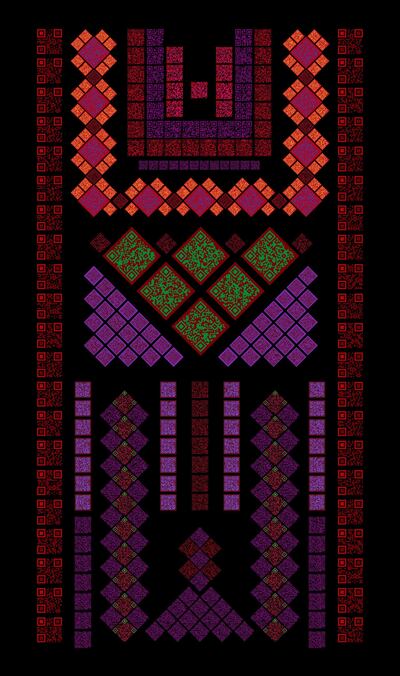
Curated by Mouna Atassi, this pop-up exhibition in one of the warehouses on Alserkal Avenue examines the lives and works of pioneering female artists in Syria across multiple generations, media and themes. The pieces reflect deeply personal stories as well as interlacing narratives from the wider backdrop of intense social and political changes in Syria, from the early 20th century to today.
“To know a society and understand it better, you must look into the role and dynamism of women,” says Atassi. “There has never been a dedicated exploration of the art scene relating to women artists in Syria. Personal Revolutions aims to fill this void, even if what we have brought together here can only ever hope to scratch the surface.”
Artists include Dorreih Fakhoury Hammad, Laila Nseir and Hiba Ansari, whose work is based on a textbook she found in the rubble of a destroyed house in northern Syria – she carved out shapes from its torn and burnt pages. Many of these artists in the show are not widely exhibited and have not previously had the opportunity to showcase their work, which makes this exhibition even more revealing. Subjects such as the role of women in the home, female identity, political unrest and war are all addressed.
The Encounter Of The First And Last Particles Of Dust by Stephanie Saade at Grey Noise
Open until May 11
The work of Lebanese artist Stéphanie Saadé uses the language of subtle nuance and is poetic and metaphorical rather than directly explicative. The works are quiet, silent and leave a trail of clues for the viewer to decipher.
Saadé always bases her work on personal experience and the title work of this show The Encounter of the First and Last Particles of Dust is made from the carpet that covered the floor of her bedroom in her family home. She returned to the home last year and removed part of the carpet which she then embroidered with gold thread plotting out 18 trajectories of events in her life that were significant between 1995 to 2001, when she lived in that room.
Not only does the work reflect the complicated thoughts and experiences of a teenager but, on a broader level it speaks of the social history of Lebanon at this time, immediately following the end of the civil war. The work therefore speaks of issues of displacement, movement, memory and territory.
The Chaser, the Ambusher and the Fickle by Bernhard Buhmann at Carbon 12
Open until May 10
Titled after the ghost characters from the classic arcade game Pac-Man, Bernhard Buhmann’s latest solo show straddles the line between the all-consuming digital age in which we live and the clunk of the analogue, which is still in living memory.
This collection of oil-on-canvas paintings dissects issues of identity and societal uncertainty considering how technologies infiltrate the world, and how they can create unease and unrest. “I am fascinated by phenomena which draw their strength from vagueness and confusion,” says Buhmann. “Those moments of historical and societal uncertainty when fears and hopes affect how we imagine the future, how we behave among each other, our emotional states.”
The basic shape of the original Pac-Man is only slightly discernible in a few of the paintings, which are otherwise full of colour blocks, lines and tightly constructed segments. At first glimpse, they appear gestural, but in fact they are considered compositions, which in that respect, also take their roots in the language of coding, the base of our digital age.
